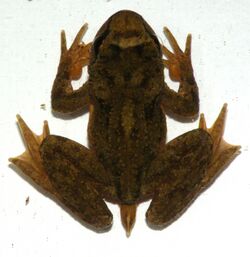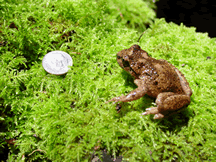Biology:Tailed frog
| Tailed frogs | |
|---|---|

| |
| Scientific classification | |
| Domain: | Eukaryota |
| Kingdom: | Animalia |
| Phylum: | Chordata |
| Class: | Amphibia |
| Order: | Anura |
| Suborder: | Archaeobatrachia |
| Family: | Ascaphidae Fejérváry, 1923 |
| Genus: | Ascaphus Stejneger, 1899 |
| Species | |
| |

| |
| Distribution of Ascaphidae (in black) | |
The tailed frogs are two species of frogs in the genus Ascaphus,[1] the only taxon in the family Ascaphidae /æˈskæfɪdiː/.[2] The "tail" in the name is actually an extension of the male cloaca. The tail is one of two distinctive anatomical features adapting the species to life in fast-flowing streams. These are the only North American frog species that reproduce by internal fertilization.[3] They are among the most primitive known families of frogs.
Its scientific name means 'without a spade', from the privative prefix a- and the Ancient Greek skaphís (σκαφίς, 'spade, shovel'), referring to the metatarsal spade, which these frogs do not have.[4][5]
Taxonomy
Until 2001, the genus was believed to be monotypic, the single species being the tailed frog (Ascaphus truei Stejneger, 1899). However, in that year, Nielson, Lohman, and Sullivan published evidence that promoted the Rocky Mountain tailed frog (Ascaphus montanus) from a subspecies to its own species.[6] Since then, the former species has been formally called the coastal tailed frog.
General morphology
The existence of the visible "tail" appendage makes this frog family distinct from all other frogs. Thus, its wider classification is difficult. It is usually classified in the ancient frog suborder Archaeobatrachia, though some say it should be a sister to all other frogs. The "tail" is found only in males, and is actually part of the cloaca, used to insert sperm into the female during mating. This anatomical feature improves breeding success by minimizing loss of sperm in the turbulent, fast-flowing streams inhabited by this species. Thus, the tailed frogs exhibit internal fertilisation, rather than the external fertilisation found in other frogs.[7]
These frogs are primitive in having a greater number of vertebrae than other frogs, in lacking the ability to vocalise, and in possessing free ribs. They are small – around 2.5 to 5.0 cm (0.98 to 1.97 in) long – and are found in steep, fast-flowing streams in Montana, Idaho, Washington, Oregon, and northern California in the northwest United States, and southeastern British Columbia (Rocky Mountain Tailed Frog) and coastal BC (Coastal Tailed Frog).
Another primitive trait that tailed frogs contain is a series of antimicrobial peptides called ascaphins. These peptides share minimal genetic characteristics with other peptides secreted by frogs, yet shows some similarities with antibacterial peptides found in African scorpions Pandinus imperator and Opistophthalmus carinatus. The ascaphin peptides are secreted through the skin and imperative in fighting bacteria such as E. coli and S. aureus.[8]
The tailed frogs share certain characteristics with the Leiopelma, a genus of primitive frogs native to New Zealand, with which they may be phylogenetic sister taxa. The prehistoric Vieraella belongs to the tailed frog family.
Mating practices
When attempting to mate, males will lunge at the female, wrapping a forelimb around them to secure them initially in a inguinal plexus formation (males wrap their digits around female anterior to the pelvic region, placing their head on the back and close to the rear of the female) and then in a ventral amplexus formation (female is flipped over and male and female venters face each other). From here, the male inserts the "tail" into the female, and squeezes the female to gain leverage before thrusting. During this process the female is relatively still, occasionally kicking during the insertion process.[9]
In some situations there is male-male competition for the female. In these situations, both males compete to enter the amplexus formation, eventually one establishing a better hold on the female and expelling the other male from the breeding process. Usually the male that is larger is more likely to succeed.[9]
General habitat

The habitat of the tailed frog is cold, fast-moving streams with cobblestone bottoms. They are mostly aquatic, but adults may emerge during cool, wet conditions to forage terrestrially. Breeding season lasts from May through September, and females deposit their eggs in strings under rocks in fast-moving streams. Larvae take one to four years to metamorphose in the cool, fast-moving mountain streams. The amount of cobbles fines in streams have been shown to be good indicators of tadpole abundance, more of each leading to an increase in tadpoles.[10]
Thermal tolerance range in adults is exceptionally low relative to other North American anurans. Adults have been observed to exhibit extreme philopatry, however, movements and migrational habits in Ascaphus have not been well documented.[11] Adults forage primarily terrestrially along stream banks, but also occasionally feed underwater. A wide variety of food items is taken, including both aquatic and terrestrial larval and adult insects, other arthropods (especially spiders), and snails. Tadpoles consume small quantities of filamentous green algae and desmids. Large quantities of conifer pollen are consumed seasonally by tadpoles.
During the day, adults seek cover under submerged substrates in the stream, or occasionally under similar surface objects close to the stream. Individuals have also been found in crevices in spray-drenched cliff walls near waterfalls. During winter, individuals are less active, especially inland, and appear to retreat beneath large logs and boulders. Tadpoles require cool streams with smooth-surfaced stones with a minimum diameter of 55 mm (2.2 in). Tadpoles probably spend most of their time attached to such substrates by a large oral sucker. The large, sucker-like mouth parts of the tadpoles are a second distinctive feature of the species, enabling survival in turbulent water unsuitable for other frogs. They prefer turbulent water to smooth, swiftly flowing water.
References
- ↑ Frost, Darrel R. (2013). "Ascaphus Stejneger, 1899". Amphibian Species of the World 5.6, an Online Reference. American Museum of Natural History. http://research.amnh.org/vz/herpetology/amphibia/?action=names&taxon=Ascaphus.
- ↑ Frost, Darrel R. (2013). "Ascaphidae Fejérváry, 1923". Amphibian Species of the World 5.6, an Online Reference. American Museum of Natural History. http://research.amnh.org/vz/herpetology/amphibia/?action=names&taxon=Ascaphidae.
- ↑ "Wildlife". Green Diamond Resource Company. http://www.greendiamond.com/environment/wildlife.asp.
- ↑ σκαφίς. Liddell, Henry George; Scott, Robert; A Greek–English Lexicon at the Perseus Project
- ↑ Dodd, C. Kenneth (2013). Frogs of the United States and Canada. 1. The Johns Hopkins University Press. p. 20. ISBN 978-1-4214-0633-6. https://books.google.com/books?id=2Hwfz9P9gS0C&pg=PR20.
- ↑ Nielson, M.; Lohman, K.; Sullivan, J. (2001). "Phylogeography of the tailed frog (Ascaphus truei): Implications for the biogeography of the Pacific Northwest". Evolution 55 (1): 147–160. doi:10.1111/j.0014-3820.2001.tb01280.x. PMID 11263735.
- ↑ Zweifel, Richard G. (1998). Cogger, H.G.. ed. Encyclopedia of Reptiles and Amphibians. San Diego: Academic Press. pp. 84–85. ISBN 0-12-178560-2.
- ↑ Conlon, Michael; Sonnevend, Agnes; Davidson, Carlos; Smith, David; Nielsen, Per (July 16, 2004). "The ascaphins: a family of antimicrobial peptides from the skin secretions of the most primitive extant frog, Ascaphus truei". Biochemical and Biophysical Research Communications 320 (1): 170–175. doi:10.1016/j.bbrc.2004.05.141. PMID 15207717. https://www.sciencedirect.com/science/article/pii/S0006291X04011520#!.
- ↑ 9.0 9.1 Stephenson, Barry; Verrell, Paul (March 12, 2002). "Courtship and mating of the tailed frog (Ascaphus truei)". Journal of Zoology 259: 15–22. doi:10.1017/S095283690200331X. https://zslpublications.onlinelibrary.wiley.com/doi/abs/10.1017/S095283690200331X.
- ↑ United States, Congress, Bull, Evelyn L., and Bernard E. Carter. Tailed Frogs: Distribution, Ecology, and Association with Timber Harvest in Northeastern Oregon, U.S. Forest Service, Pacific Northwest Forest and Range Experiment Station, 1996.
- ↑ Adams, S. B., & Frissell, C. A. (2001). Thermal habitat use and evidence of seasonal migration by Rocky Mountain tailed frogs, Ascaphus montanus, in Montana. Canadian Field-Naturalist, 115(2), 251-256.
- Gissi, Carmela; Diego San Mauro; Graziano Pesole; Rafael Zardoya (February 2006). "Mitochondrial phylogeny of Anura (Amphibia): A case study of congruent phylogenetic reconstruction using amino acid and nucleotide characters". Gene 366 (2): 228–237. doi:10.1016/j.gene.2005.07.034. PMID 16307849.
- Roelants, Kim; Franky Bossuyt (February 2005). "Archaeobatrachian paraphyly and pangaean diversification of crown-group frogs". Systematic Biology 54 (1): 111–126. doi:10.1080/10635150590905894. PMID 15805014.
- San Mauro, Diego; Miguel Vences; Marina Alcobendas; Rafael Zardoya; Axel Meyer (May 2005). "Initial diversification of living amphibians predated the breakup of Pangaea". American Naturalist 165 (5): 590–599. doi:10.1086/429523. PMID 15795855. http://kops.ub.uni-konstanz.de/bitstream/handle/urn:nbn:de:bsz:352-opus-33053/Initial_Diversification_of_Living_Amphibians_Predated_the_Breakup_of_Pangaea.pdf.[|permanent dead link|dead link}}]
- Excerpt from Zeiner et al. 1988 describing tailed frogs
External links
Wikidata ☰ Q2925426 entry
 |


